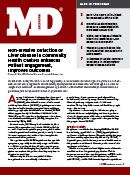Publication
Article
MD Magazine®
Non-Invasive Detection of Liver Disease In Community Health Centers Enhances Patient Engagement, Improves Outcomes
Robert G. Gish, MD

In 2013, Dr. Gish joined the consulting faculty at La Maestra in San Diego, California, to establish a liver care program in the Federally Qualified Health Care clinic. His integral role in the diagnosis, treatment and management of patients with NAFLD and NASH provides valuable guidance for this specialized sector of patient care.
Among the diseases that impact Americans and their caregivers, non-alcoholic fatty liver disease (NAFLD), also referred to as metabolic associated fatty liver disease (MAFLD), is gaining more attention. An umbrella term for a range of liver conditions affecting people who drink little to no alcohol, NAFLD affects approximately 100 million individuals in the United States. The prevalence for its more serious form, non-alcoholic steatohepatitis (NASH), is expected to increase by 63% by 2030.
In some cases, NASH may lead to cirrhosis, liver cancer, liver transplant and death. NASH, which is associated with nonspecific symptoms, and is often underdiagnosed and underreported, recently became the most common reason for a liver transplant in women and older patients.
Most patients with NASH experience few specific symptoms, especially in the early stages of the disease. When a patient feels well or has vague symptoms, it can be challenging for physicians and caregivers to convince the patient that they may have a dangerous condition.
Community health centers, which deliver exceptional care to medically underserved populations, share a common goal of providing coordinated, culturally competent and community-directed primary and preventive health care services. Today they deliver care to 29 million people across the country.
Physicians at community health centers play a critical role in not only helping to educate patients about the importance of liver for overall health, but also identifying the best approaches for preventing the progression of NAFLD.
Who is at Risk?
People most at risk for developing NAFLD or NASH have obesity, type 2 diabetes (T2D), hyperlipidemia and/or metabolic syndrome. Hispanic and Latino populations are disproportionately affected by NAFLD, depending on genetic factors, access to health care or the prevalence of chronic diseases, such as metabolic syndrome or diabetes.
Health center patients have higher rates of chronic conditions than the general population. This is important to note because the presence of T2D accelerates the progression of liver disease in patients with NAFLD, and NAFLD is an independent predictor associated with a more than two-fold increase in developing T2D.
Researchers have found NAFLD, hepatitis C, liver cancer and liver transplants are prevalent in 40-80% of people who have T2D and in 30-90% of people who are obese. Being overweight or obese is responsible for about 85% of fatty liver disease.
Enhancing Patient Engagement
Because NAFLD and NASH are so tightly intertwined with obesity, diabetes and lifestyle, a “whole person” approach to patient engagement is needed to support behavioral changes that will result in better outcomes across the co-morbid conditions affecting the individual patient.
Early detection is needed because lifestyle modifications and strict control of metabolic risk factors are the most effective treatment. Because disease progression is typically slow, patients can be managed well by primary care physicians. NAFLD patients with advanced liver fibrosis should be referred to specialist care for further assessment.
While finding and managing fibrotic NASH is an important component to addressing liver disease, patients with steatosis alone are at a greater risk of cardiovascular mortality and morbidity.
Physicians should consider integrating non-invasive, point-of-care liver examinations as a way to improve patient intake, outcomes, lower costs and enhance income stream. FibroScan, for example, is an FDA cleared technology for the diagnosis and monitoring of adult patients as part of an overall evaluation of liver health.
Unlike blood tests that measure circulating markers of inflammation, such as alanine aminotransferase (ALT) and aspartate aminotransferase (AST), this tool directly and non-invasively measures physical properties of stiffness and liver fat.
It provides reproducible results, allowing for both diagnosis and monitoring of liver stiffness and liver fat, and has been recognized as a cost-effective tool for screening and also identifying cirrhosis in people with NAFLD. This information can support care management across key components of the metabolic syndrome – diabetes and hyperlipidemia.
Early Interventions
When it comes to treating NAFLD, diet and exercise interventions are the first line of therapy, with the goal of decreasing body weight and modifying cardio-metabolic risk factors related to metabolic syndrome. In the early stages of NAFLD, a healthy diet and weight loss of at least 7% might be sufficient. Patients are often treated with vitamin E as well. Aggressive management of hypertension, diabetes and lipid disorder is also key.
San Diego-based La Maestra, a health center serving low-income and immigrant residents, has seen an alarming rise in liver disease. Because of this, every liver patient at La Maestra undergoes a rapid, non-invasive point of care examination, which validates that they have determined elastography with CAP to be an essential part of a patient’s workup, along with a full abdominal ultrasound that includes special liver cancer biomarkers, a liver panel that includes liver enzymes and liver function, chemistry panel and a CBC as well as APRI, FIB4 NAFLD score calculations.
La Maestra has found it to be particularly useful to share the patient’s liver health score and CAP with patients who have NAFLD to illustrate the change in liver fat and the need for adjusting their treatment and calculation of the FAST score.
Physician practices working in the community health center setting can play a significant role in helping to reverse the nation’s liver disease epidemic through early detection and monitoring of NAFLD/NASH.
Ultimately, having a non-invasive tool at the point of care to examine liver health provides quantifiable information that can improve individual health outcomes, lower payer costs by avoiding expensive, invasive interventions and enhance the financial performance of a physician practice.






